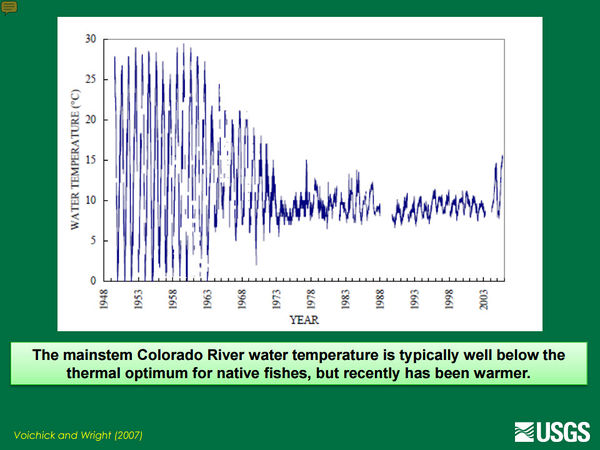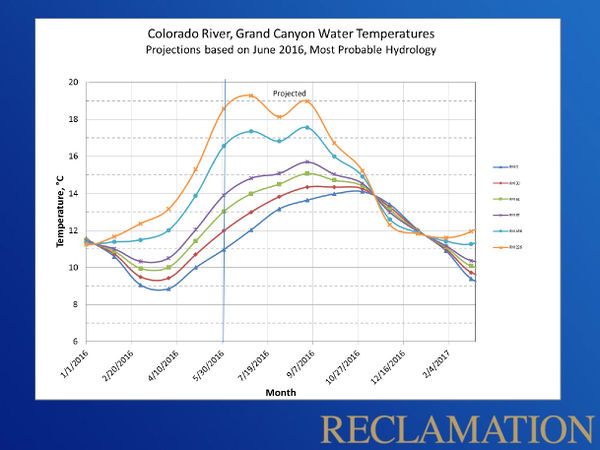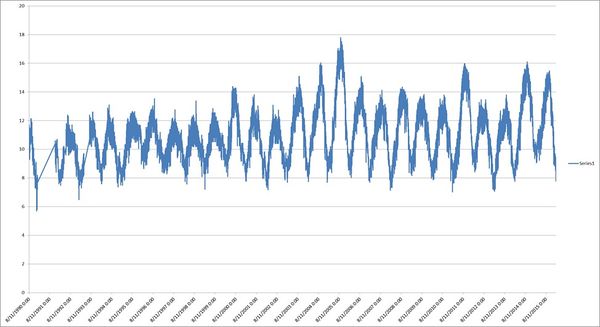Difference between revisions of "TEMPERATURE"
From Glen Canyon Dam AMP
Cellsworth (Talk | contribs) |
Cellsworth (Talk | contribs) |
||
| Line 39: | Line 39: | ||
{|style="margin:0px 0px 0px 0px; background:none;" | {|style="margin:0px 0px 0px 0px; background:none;" | ||
| − | |class="MainPageBG" style="width: | + | |class="MainPageBG" style="width:55%; border:1px solid #cef2e0; background:#f5faff; vertical-align:top; color:#000;"| |
{|width="100%" cellpadding="2" cellspacing="5" style="vertical-align:top; background:#f5faff;" | {|width="100%" cellpadding="2" cellspacing="5" style="vertical-align:top; background:#f5faff;" | ||
! <h2 style="margin:0; background:#cedff2; font-size:120%; font-weight:bold; border:1px solid #a3bfb1; text-align:left; color:#000; padding:0.2em 0.4em;">Updates</h2> | ! <h2 style="margin:0; background:#cedff2; font-size:120%; font-weight:bold; border:1px solid #a3bfb1; text-align:left; color:#000; padding:0.2em 0.4em;">Updates</h2> | ||
| + | |- | ||
| + | |style="color:#000;"| | ||
| + | [[File:2016 ModeledRiverTemps.jpg|600px]]<br> | ||
| + | The timing of when releases are the warmest and when warm air temperatures have the greatest potential to warm the river has a large influence on downstream river temperatures. The warmest release temperatures occur in late October/early November but the greatest potential of warming the river in Grand Canyon occurs in July and September when air temperatures are the hottest. The reason is that it takes a lot longer to warm all the water in Lake Powell vs the water in the river as it flows downstream. | ||
|- | |- | ||
| Line 68: | Line 72: | ||
|- | |- | ||
|style="color:#000;"| | |style="color:#000;"| | ||
| − | |||
| − | |||
| − | |||
| − | |||
| − | |||
| − | |||
| − | |||
| − | |||
| − | |||
| − | |||
| − | |||
| + | *[http://www.gcmrc.gov/discharge_qw_sediment/station/GCDAMP/09380000 Colorado River at Lees Ferry] | ||
| + | *[http://www.gcmrc.gov/discharge_qw_sediment/station/GCDAMP/09383050 Colorado River at 30 mile] | ||
| + | *[http://www.gcmrc.gov/discharge_qw_sediment/station/GCDAMP/09383100 Colorado River above LCR] | ||
| + | *[http://www.gcmrc.gov/discharge_qw_sediment/station/GCDAMP/09403000 Bright Angel Creek] | ||
| + | *[http://www.gcmrc.gov/discharge_qw_sediment/station/GCDAMP/09402352 Colorado River abv Lava Canyon rm66] | ||
| + | *[http://www.gcmrc.gov/discharge_qw_sediment/station/GCDAMP/09403270 Colorado River bl rm127] | ||
| + | *[http://www.gcmrc.gov/discharge_qw_sediment/station/GCDAMP/09403850 Kanab Creek] | ||
| + | *[http://www.gcmrc.gov/discharge_qw_sediment/station/GCDAMP/09404115 Havasu Creek] | ||
| + | *[http://www.gcmrc.gov/discharge_qw_sediment/station/GCDAMP/09404120 Colorado River abv National Canyon] | ||
| + | *[http://www.gcmrc.gov/discharge_qw_sediment/station/GCDAMP/09404200 Colorado River bl Diamond Creek] | ||
| + | *[http://www.gcmrc.gov/discharge_qw_sediment/station/GCDAMP/09404220 Colorado River abv Spencer rm246] | ||
| Line 88: | Line 92: | ||
| − | 2010 | + | '''2010''' |
| − | + | *[http://www.usbr.gov/uc/rm/amp/amwg/mtgs/10aug24/Attach_12a.pdf/ Selective withdrawal and sediment augmentation update] | |
| Line 96: | Line 100: | ||
|- | |- | ||
|style="color:#000;"| | |style="color:#000;"| | ||
| − | * | + | |
| − | * | + | *[http://gcdamp.com/index.php?title=TCD_Learning_Page/ TCD Learning Page] |
| − | * | + | *[http://www.gcdamp.gov/tcd/ GCDAMP TCD Page] |
| + | *[http://www.usbr.gov/uc/rm/amp/tcd// Reclamation TCD Page] | ||
| + | *The 2000 Low Summer Steady Flow Experiment | ||
| + | *The Fall Steady Flow Experiment | ||
| + | |||
|} | |} | ||
---- | ---- | ||
Revision as of 11:24, 13 July 2016
|
|
Prior to completion of Glen Canyon Dam in 1963, the temperature of water flowing through the Grand Canyon each year was highly variable, ranging from the icy, spring run-off to the warm, 85-degree summer-heated flows. However, once the dam was constructed, the temperature of the water released from the dam - drawn from the depths of Lake Powell and released through the dam's large penstock intakes - ranged for many years between 45 to 50 degrees. With the lowering of Lake Powell, release temperatures have been increased to as high as 57 degrees which has likely led to an increase in the humpback chub and other native fish populations in Grand Canyon. |
| --- |
--- |
--- |
|---|
|
|
|


